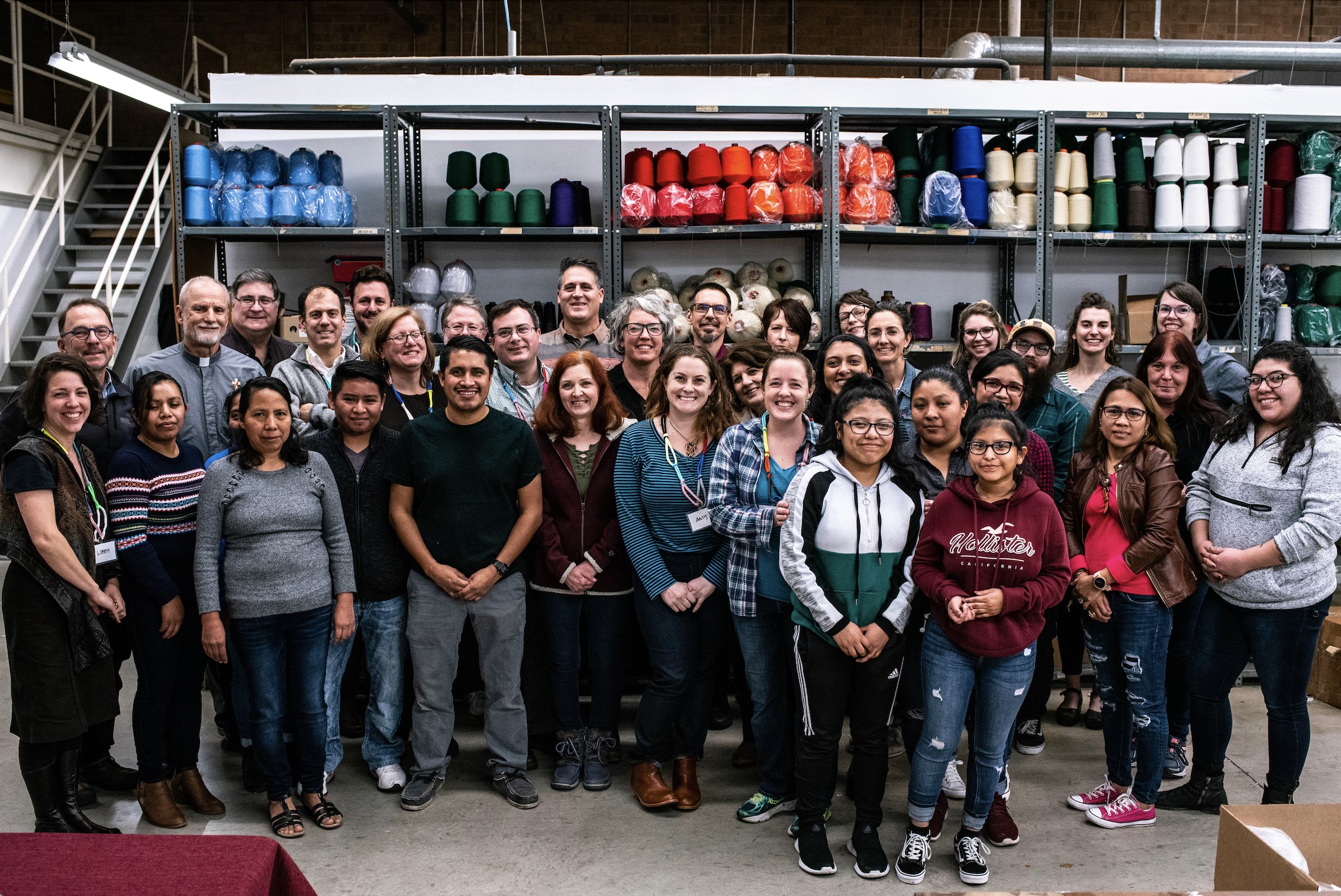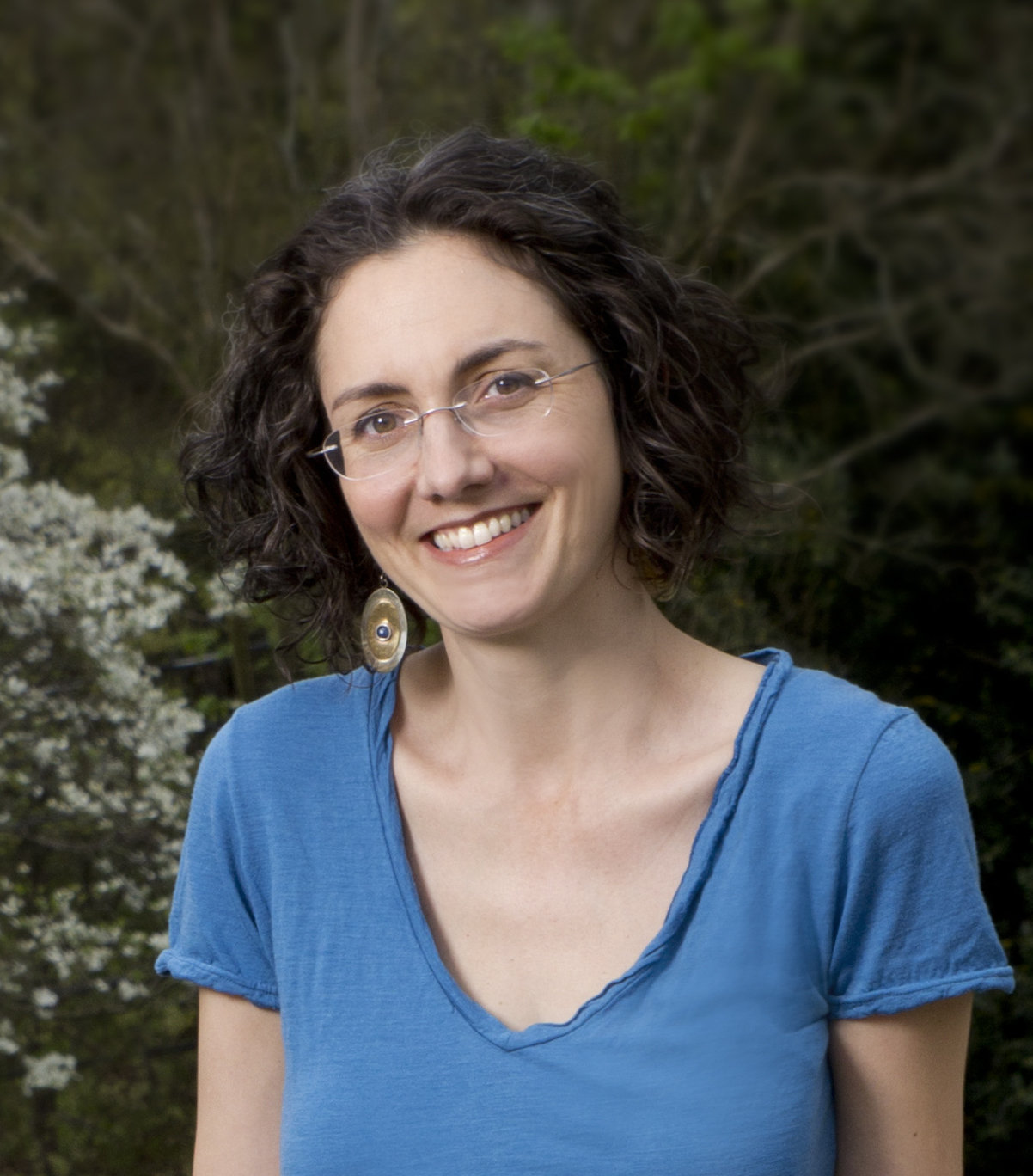The Industrial Commons, located in Morganton, North Carolina, houses an incredible ecosystem of cooperatives and enterprises, all committed to “rebuilding a diverse working class based on locally rooted wealth.” The emphasis is not solely on building and supporting businesses; it’s about building and supporting the workforce behind those businesses. This goes far beyond providing basic needs and wants in a work environment. It includes shifting the perspective on what it means to be a worker and what humanizing the manufacturing industry looks like. The Industrial Commons has launched six cooperatives so far and is in the process of redeveloping a 28-acre brownfield site for their Innovation Campus, which will help further their efforts to revitalize textile manufacturing in the rural South; provide training and youth development programs; uphold a circular economy; and create thriving networks with equal representation.
—Charlotte DeFazio
The Industrial Commons is one giant umbrella. Could you briefly explain the different cooperatives and enterprises that fall under it?
At the big umbrella is our mission of rebuilding a diverse working class based on locally rooted wealth. That is our guiding principle. In that, we needed to create companies, so that’s what we started with Opportunity Threads, and then we built this network called the Carolina Textile District. Instead of all of us being out there on our own, we band together. Using a cooperative form—even though we might not necessarily be individually organized as cooperative businesses—we can solve the problems of the industry together.
Some of the things we’ve done is launch industrial sewing programs in regional community colleges in the western part of the state. After that, the Department of Public Instruction came to us and asked us to help have input on the textile classes in high schools across North Carolina. Then people wanted to give us money—we did things backwards. That’s where we built the 501c3 to say we can bring more resources in to create programs and businesses, and support existing businesses and networks. The other part of our solution is that we have to get much further upstream with the workforce, so not trying to convince people when they’re in their twenties and thirties, but really starting to work with the much younger generation of workers, rethinking and reimagining what the future of work and sustainable work looks like. That’s where our workforce and education programs like TOSS come in.
There’s two main pieces of our work with The Industrial Commons. There’s building and supporting businesses, and there’s building and supporting workers. We think about those workers from the time they’re in fourth and fifth grade as not just workers of production, but as creative minds that will help bring our community and this planet into a more sustainable and thriving place to be.
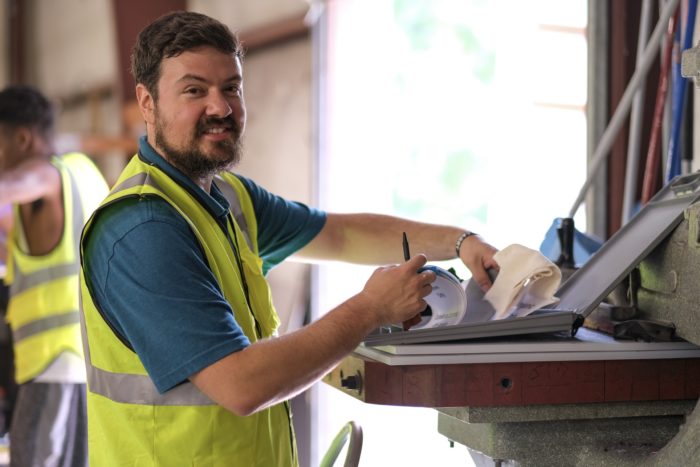
How have you flipped the script and changed what it means to be a worker, especially with a younger generation bombarded by so many outer influences?
We probably have not completely flipped it, but we’re in the process of flipping. It’s more than just punching the clock. The human piece of work is what we forget about. What’s interesting though is that when you follow the studies, businesses do better when workers are engaged, and employee ownership is a tool for engagement in the workplace. At the end of the day, we still need markets and money to be circulating and we still need people to appropriately buy, but there are tools we can bring to humanize work and make it effective. You can have a thriving business and agency opportunity for people. It can be a green industry and work really well as a business. Those intersections of things aren’t mutually exclusive as we’re so often told they are. We’re trying to prove that at scale.
What’s unique about where we live is we have this industry that is ripe for ushering in a complete renaissance around textiles and furniture from a very green, sustainable place. A lot of that is still done in Western North Carolina so we’re lucky that our infrastructure remains relevant for U.S. production. There is this real yearning to get new generations involved. It’s not pizza parties and cool vending machines; it’s agency opportunity and self-development. And the work is still hard. The work still looks the same, but the process of the work can be fundamentally different and more humanized.
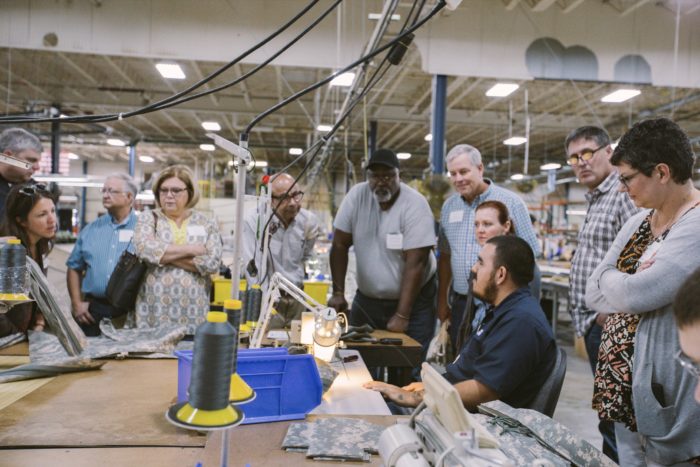
What would humanizing this work look like?
There are really good studies out there on what people want in the workplace. There’s fundamental things you need like safety, good pay, benefits, and predictable work hours. Then as you go up, there’s training, pathways for leadership, and as you go further up, there’s profit sharing and elected roles into decision making. There’s a whole scale of tools that are available for workforces that are tried and true and have been researched. Unionization is a great way to do that though our area is one of the least unionized parts of the United States. We’re often working with very small plants (5-50 people) who don’t necessarily lend themselves well to unionization, but there are these other models like cooperatives. We build something called worker committees where we go into plants and have groups of frontline workers interfacing with management to create stronger, healthier workplace culture. It’s a really beautiful opportunity in a gray area of humanizing and greening the workspace. That is the future of workforce development and the future of what manufacturing needs to look like.
And there’s been a shift since the pandemic as well. The work has likely become even more lucrative with more production being done at home since so many supply chains were disrupted.
Exactly right, and there’s a good documentary we made about a project we did with masks and gowns. That was one of the crowning achievements of the Carolina Textile District. During the pandemic, we pulled 60 mills together and got one contract with the state for creating masks and gowns, mainly for daycares. We designed a reusable mask with a clear mouthpiece because students were falling behind in language acquisition since they couldn’t see how people were learning to talk. We made over 700,000 units, and no single mill could have gotten that contract. Because we banded together, we were able to do things quickly and paid out close to 4 million dollars to keep a lot of folks working, keep the mills open, and provide a great service for the state.
We call it coopetition. Sometimes you might be competing with that mill beside you, but there are times when we need to band together. Unfortunately, so much entrepreneurship and innovation is seen as this one sole person, often a white male person. There are really functional ways to move in creative economies that can be scaled, be sustainable, and still have strong business practices.
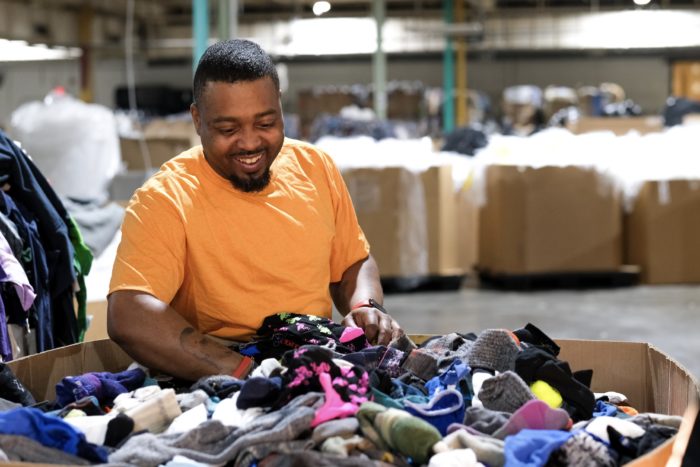
Which cooperative ecosystems inspired the model for The Industrial Commons?
There are two places. One is in the Mondragon region of Spain, which is now a multi-billion dollar entity spanning the globe with up to 80,000 workers in their network. It started as a company led by a Catholic priest [José María Arizmendiarriet] and five workers. They had very humble beginnings coming out of the Spanish Civil War when there was deep destruction in this rural community that had the potential for a manufacturing base. We take a lot of inspiration from the Mondragon Corporation, and it’s worth looking them up. We also look at a really interesting region of Italy called the Emilia Romagna, where there’s a lot of cooperation among supply chains.
During the pandemic, we wrote a paper on six different cooperative ecosystems globally: Quebec, Northern Italy, the Mondragon group in Spain, the Arizmendi Association of bakeries in San Francisco, and a newer collection of cooperatives in Seoul, South Korea. Through this paper we ask, “What should we be building on or avoiding? What are the commonalities of strong cooperative or solidarity economies that have survived over generations?”
Have you noticed if any places in the U.S. are looking at your model to use in their own communities?
Sure. We are taking a place-based strategy of a region and an industry, layered with this specific bend towards sustainability and labor. There is something unique to our region, but there are also people doing phenomenal work in other regions. Co-op Cincy in Cincinnati is not necessarily building through one supply chain, but is really trying to build a saturation of worker-owned companies. We look to them, but in some ways we really keep our heads down to try to have something grow in the rural South. There is something specific about working in the rural South. We feel like if you can do it here in a very red state, in a very red region, then these are universal principles that need to be depoliticized to create sustainable futures for everyone.
So it’s place-based and assets. This is why we’re hesitant to franchise. We’ve even turned down money when people have come and said go build this in other regions. That’s not who we are. We know our people in our region. Someone else in another region has a different asset, but assets have grown up in a region for a reason. Let’s really study the assets that we have and figure out where the holes in these networks are, and then build into those.
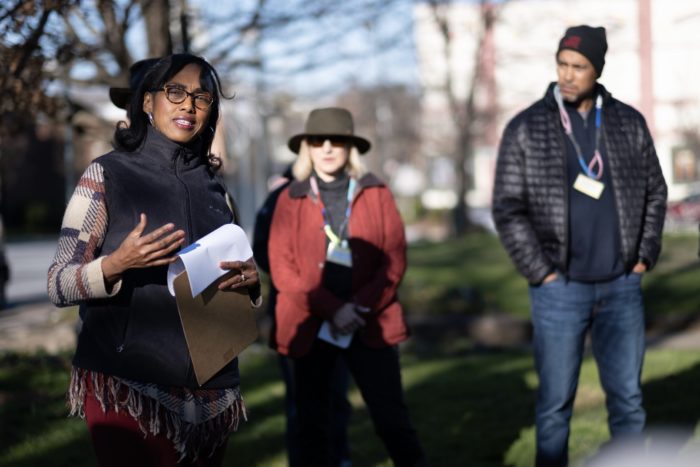
How are you implementing environmental initiatives?
We have a wonderful partnership with Smartwool. Right now, we believe it’s the largest scaled circular project in the U.S. that’s taking back post-consumer textiles. We take back thousands upon thousands of socks and sort them. Instead of having this afterthought of environmental sustainability, it is the core competency of our business. At Opportunity Threads, we are up-cycling. We up-cycle about 70,000 T-shirts every week. We take back waste and get it back into the supply chain from a one-to-one, which is very rare. A lot of people are down-cycling things—grinding it up, creating purpose, and not dumping it in the landfill. But I think what we’ve been able to build is unique. With Smartwool, we’ve gone from a sock back to a sock.
And the newest co-op we’ve started, called Seat at the Table, is around furniture. Instead of putting more stuff into the world, let us be the service for circularizing the industries that are already here. What about when you go clear out a hotel and have all these chairs to take back? How can there be a service that’s built into the region to be able to do that? That’s what we’re working on now.
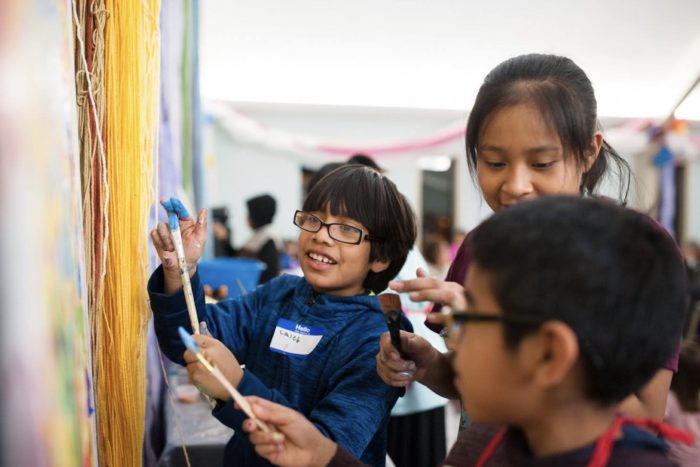
Something important to discuss is the notion that simply creating more jobs doesn’t eliminate inequity and generational poverty. Why is that?
I watched it happen growing up, and my co-executive director, Sara Chester, also came from traditional economic development. A lot of what traditional economic development does is recruitment, so there are recruiting companies from the outside that are usually given business incentives. Often, those companies leave. I can think of several companies who were brought into our community, created jobs and then left. Yes, during that time they created a job, but looking at the long arc of justice, that job was then extracted from our community. We want to undo these models of extraction. Extraction is what a lot of rural communities have suffered from. Coal, lumber, water, whatever it is—many of the folks working in these factories are doing all the work and then a brand is just putting their name on it. There is a facelessness in the extraction of contractual work.
But how do you reverse wealth extraction over generations? A job is great, but what about having more of a stake in the profit of that company to at least have a say in if the company stays or goes? And if you do have wealth, what do you do with it? If you have a great job, do you buy the $80,000 truck or do you buy the $40,000 truck and invest $40,000? As people come out of situations of poverty, how are they thinking about the individual wealth they have? And then how as a community are we thinking about community wealth? Something that’s happening, and I think a challenge during the pandemic, is a lot of people started moving into rural communities and buying everything up because it was cheaper. One of the projects we have at The Industrial Commons is looking at housing and buying property [Land for the Commons] so that the physical wealth of our land stays in our community. We have a large development project right now in the heart of our downtown that was a factory that burned down, and has been sitting for 13 years.
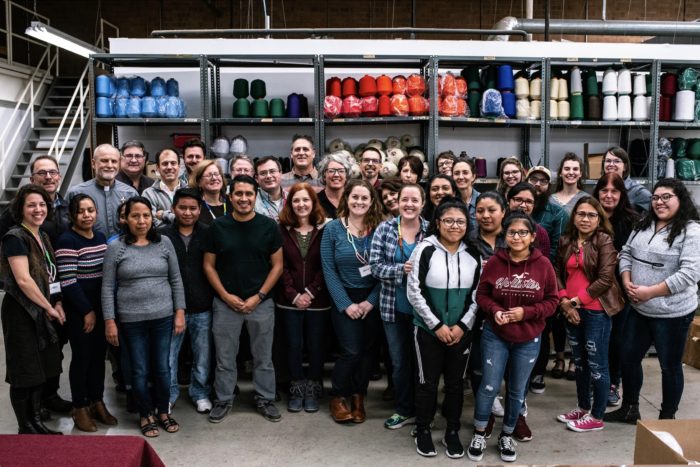
Is that your innovation campus?
Yes, it’s very exciting. We always knew we were going to run out of space, and that was just our learned experience from the first factory I built. Circularity and raw material take up a lot of space. We probably have 200,000 pounds of materials waiting to be processed right now, so we knew space was going to be something we needed.
We purchased the land, and got an initial EPA grant for cleaning it up so we’re going to start cleaning in the next few months. And then we will get our first building up on the land, which will be for industrial training programs. We’re also going after high environmental standards with the Living Building Challenge, and ended up getting Mithun as the lead architect so we feel like we’re in good hands trying to find this intricate dance between beauty, functionality, sustainability and Southern identity to put something new together that embodies all of the creative work going on around these factories that no one sees.
How can readers show support?
Buy a pair of Smartwool socks. That gives us work and proves the concept. Folks are also welcome to join our newsletter, and if there are high-wealth individuals interested in this work, we’re always looking for fundraisers for the new building we’re putting in. If anyone has knowledge on green buildings, we welcome that as well. Lastly, just being engaged and learning and being a conscious consumer is really important.

